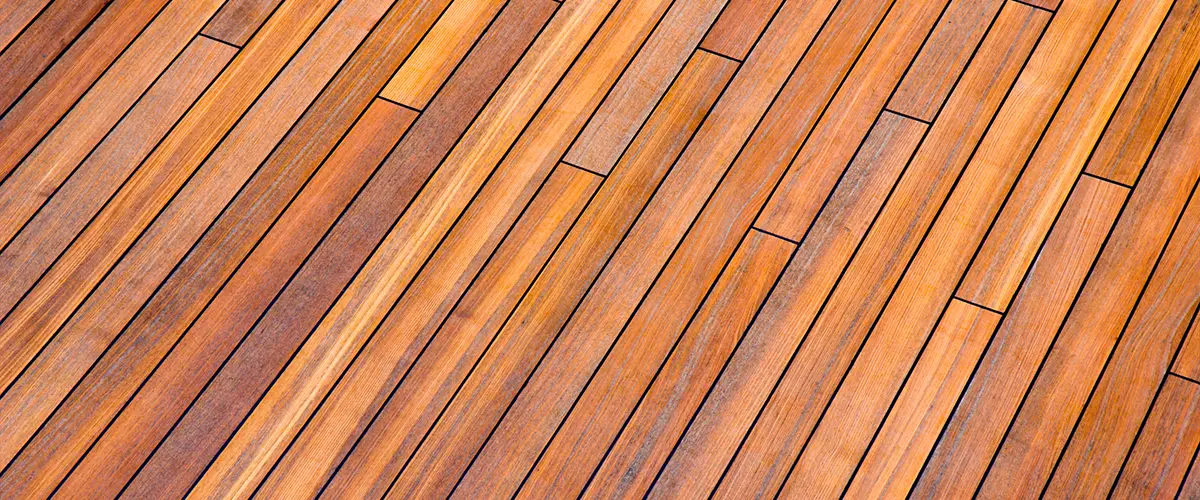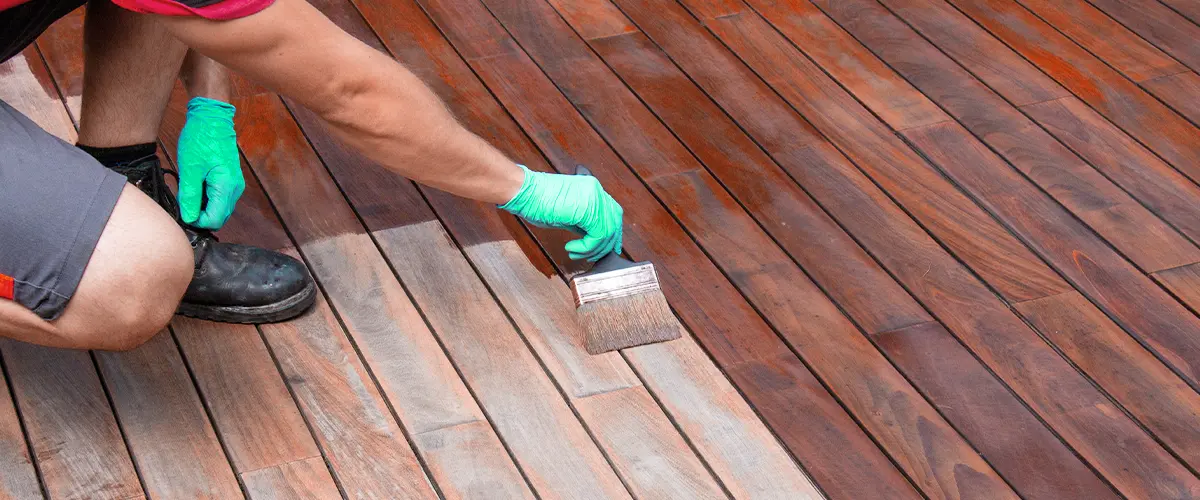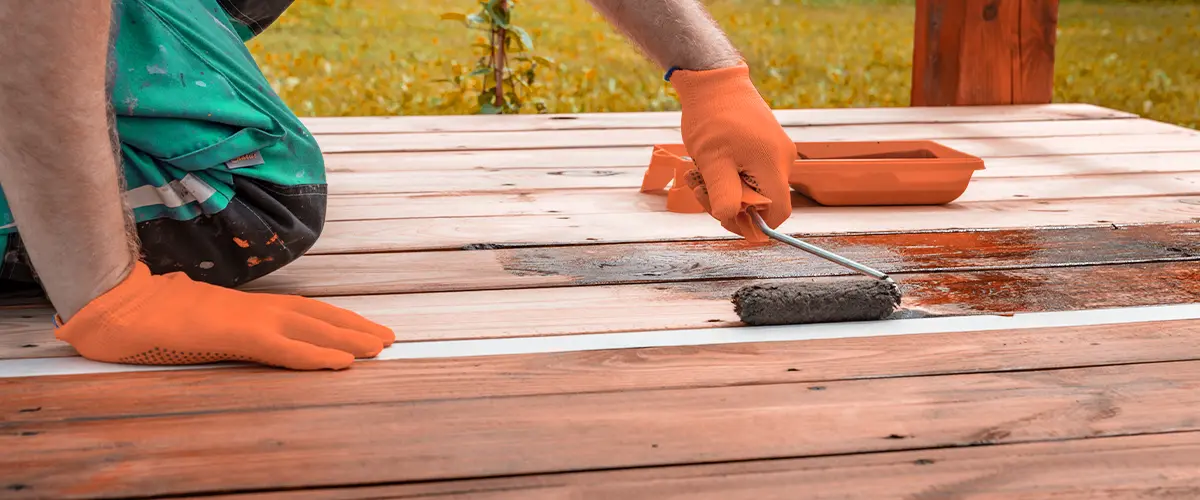Oil Vs Water-Based Deck Stains: Which is Best?
Choosing the right deck stain is a common challenge for homeowners. Did you know oil and water based stains both offer unique benefits for your deck? This article will guide you through understanding these differences, making it easier to protect and beautify your exterior wood surfaces.
Discover which stain is best for your deck.

Key Takeaways
- Oil-based stains soak deeply into the wood, making them great for protection and enhancing the natural grain. They need more care when cleaning up since they require mineral spirits.
- Water-based stains dry quickly and are easier to clean with just soap and water. They offer good UV protection but might not last as long in harsh weather compared to oil-based options.
- Choosing the right stain depends on your wood type, if it's indoor or outdoor, what color you want, and how much protection is needed.
- For longer-lasting decks exposed to sunlight, oil-based stains provide better UV resistance. However, they require more frequent reapplications than water-based stains.
- Water-based stains are eco-friendly and have a low odor during application, making them a convenient choice for quick projects with easy cleanup needs.
The Differences Between Oil and Water-Based Stains
Oil-based stains penetrate deeply into the wood, enhancing its natural beauty. Conversely, water-based stains form a coating on the surface of the wood, offering protection from moisture and UV rays.
Why use deck stains?
Stains serve a crucial role in protecting wood surfaces while enhancing their natural beauty. They penetrate deep into the wood, offering protection against moisture, UV rays from the sun, and wear from foot traffic. If you live in a sunny area, we recommend checking our article on best stain for decks in full sun.
Solid stains and semi-transparent stains allow homeowners to showcase or alter the natural grain of the wood according to their aesthetic preferences.
Staining decks and exterior surfaces adds durability and longevity to these areas exposed to extreme weather conditions. A well-applied coat can prevent water damage, reduce peeling, and maintain the rich color of the wood for longer periods.
For both oil-based stains and water-based products, proper application helps shield decks from dirt accumulation and moisture penetration which could lead to mold growth.
Composition of Oi Based deck stains vs Water-based
Oil-based stains soak into wood, enhancing the wood grain and providing a rich appearance. These stains contain natural oils mixed with chemicals to protect decking from water and UV damage.
They penetrate deep, making them great for horizontal surfaces prone to harsh elements. Water-based products are different. They sit on the surface but still offer good protection.
Made with synthetic resins and eco-friendly ingredients, they resist mold and fading better than oil-based options. Both types come in semi-transparent styles that let the beauty of the pine or other woods show through while adding color.
Choosing between oil or water-based deck stain comes down to what you want your deck to look like and how much maintenance you’re willing to do. Oil stains need more frequent reapplication but provide deeper enhancement of wood’s natural patterns.
Water stains are easier for clean-up, needing just soap and water, plus they’re less prone to causing lap marks during application because they dry slower than their oil counterparts.
Whether protecting siding or decking, understanding these compositions helps achieve desired durability and appearance without over-application risks.
Pros and Cons of Oil-based Stain vs Water-based Stains
Moving from the composition of oil and water-based stains, it’s essential to delve into the specifics of their advantages and disadvantages. This comparison will help homeowners make informed decisions about the best type of stain for their decks.
Oil-Based Stains
| Pros | Cons |
|---|---|
| Deep penetration into wood | Requires mineral spirits for cleanup |
| Better adhesion | High Volatile Organic Compound (VOC) levels |
| Longer drying time allows for a more even application | Strong odor |
| Non-flammable | Flammable |
| Contains UV inhibitors and synthetic resins for color retention | Can take longer to dry, depending on weather conditions |
Water-Based Stains
| Pros | Cons |
|---|---|
| Enhanced durability | May not penetrate as deeply into wood |
| Natural resistance to water and mold | Can be more susceptible to peeling and wear in high-traffic areas |
| Quick drying time | Application can be more challenging in cooler temperatures |
| Easy cleanup with soap and water | |
| Low odor | |
| Eco-friendly options available |

How to Choose Between Oil and Water-Based Stains
- Consider type of wood
When choosing between oil and water-based stains for your deck, consider the type of wood you are working with. Different types of wood absorb stains differently, so it’s important to select a stain that complements the characteristics of your specific wood.
For example, dense hardwoods like mahogany may work better with oil-based stains as they penetrate deeper into the wood, providing enhanced protection and durability. On the other hand, softer woods such as pine or cedar might benefit from water-based stains that offer flexibility and quick drying times.
- Better penetration into wood
When making a choice between oil and water-based stains, take into account the use of the area. Water-based stains are a suitable option for outdoor spaces such as decks, patios, and fences, where they provide superior UV protection and withstand harsh weather conditions.
Conversely, if you’re looking to finish interior surfaces like hardwood floors or furniture, oil-based stains offer greater durability and require less maintenance over time.
Remember that for areas with high foot traffic or frequent use like interior flooring, oil-based stains are the better choice in terms of durability. On the other hand, water-based stains are advantageous for outdoor structures, as they resist fading from UV exposure more effectively.
- Color preferences
When choosing between oil and water-based deck stains, consider your color preferences. Water-based stains offer a wide range of colors, from natural wood tones to vibrant hues, making it easier to match the aesthetic of your home.
On the other hand, oil-based stains generally have fewer color options but tend to enhance the natural grain of the wood for a rich and traditional look. It’s important to factor in your personal style and the overall design scheme when deciding on color preferences for your deck stain.
Next, let’s explore the level of protection needed for different types of wood surfaces.
- Level of protection needed
When considering the level of protection needed, it’s important to factor in the wood’s exposure. For exterior use, where decks are subject to harsh weather conditions and UV rays, a stain with strong protective qualities is essential.
Oil-based stains offer superior water resistance and durability against weathering, making them ideal for outdoor use. Water-based stains may be suitable for indoor applications or areas with less exposure to the elements but could require more frequent reapplication for adequate protection.
Considering the type of wood and its intended location is crucial when selecting a stain that provides long-term protection against environmental factors such as moisture, sunlight, and foot traffic on decks.
As you decide on the level of protection needed for your deck from oil vs water-based stains, keep in mind these key factors that will safeguard your investment in both appearance and longevity.

Top Deck Stain Manufacturers
When selecting a deck stain, choosing products from reputable manufacturers can ensure quality and durability. Here are some of the best:
- Behr: Behr is known for its wide range of vibrant colours and excellent protective formulas, ideal for varied climates.
- Olympic: Olympic offers a variety of stains with strong resistance to moisture and UV damage, suitable for any decking material.
- Cabot: Cabot’s stains are praised for their rich pigments and long-lasting finishes, ensuring a beautifully preserved deck.
- Rust-Oleum: Rust-Oleum specializes in protective coatings, providing reliable stains that resist fading and maintain wood’s natural beauty.
FAQs About Oil Vs Water-Based Deck Stains
Oil-based stains differ from water-based stains in their finish, application, and eco-friendliness. Oil-based products usually offer a semi-transparent look while water-based ones might not.
Yes, you can apply an oil-based or semi-transparent stain over an existing one. But don’t put too much! Over-application may lead to unwanted results.
Water based products are often more eco-friendly than oil based ones. Make sure to check the product details before making your decision.
The best choice depends on your needs and market availability of painting versus staining materials. A semi-trans option might give a more natural look compared to painting. You can also read our article on solid stain vs paint for decks to help you make a more informed choice.
Consider factors like the desired finish, whether it’s over an existing stain, if you prefer eco-friendly options, and what’s available in the market to make the best decision.
Experienced Professionals You Can Trust
With years of dedicated service in deck staining, our team of professionals ensures exceptional results. Working with the best saves you money and time. Ready to start your deck repair or deck installation project? Contact us at (215) 608-6886 today!
